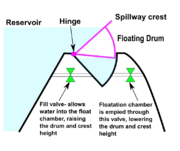Floodgate
From Wikipedia, the free encyclopedia.
Floodgates are adjustable gates to control water flow in reservoir, stream or levee systems. They may be designed to set spillway crest heights in dams, to adjust flow rates in sluices and canals, or they may be designed to stop water flow entirely as part of a levee or storm surge system.
Contents |
Types of floodgates

A sluice gate on the Harran canal.
|
- Bulkhead gates are vertical walls with movable, or re-movable, sections. Movable sections can be lifted to allow water to pass underneath (as in a sluice gate). Designs with removable sections allow water to pass over top and historically used stacked timbers to set the dam's crest height. Some floodgates in large levee systems slide sideways to open for various traffic. Miter gates are used in ship locks and usually close at an 18° angle to approximate an arch.

Fish belly flap gates at the Scrivener Dam, Canberra.
|
- Hinged crest gates, are wall sections that rotate from vertical to horizontal, thereby varying the height of the dam. They are generally controlled with hydraulic power.
- Variations;
- flap gate
- fish-belly flap gates
- Bascule® gates
- Pelican® gates

Tainter gate diagram.
|
- Radial gates are rotary gates consisting of cylindrical sections. They may rotate vertically or horizontally. Tainter gates are a vertical design that rotates up to allow water to pass underneath. Low friction trunnion bearings, along with a face shape that balances hydrostatic forces, allow this design close under its own weight as a safety feature.

Drum gates on a diversion dam.
|
- Drum gates are hollow gate sections that float on water. They are pinned to rotate up or down. Allowing water into or out of their flotation chamber adjusts the dam's crest height.

A roller gate on the Mississippi.
|
- Roller gates are large cylinders that move in an angled slot. They are hoisted with a chain and have a cogged design that interfaces with their slot.
- Clamshell gates have an external clamshell leaf design.
Floodgate valves
Valves used in floodgate applications have a variety of design requirements and are usually located at the base of dams. Often, the most important requirement (besides requlating flow) is energy dissapaion. Since water is very heavy, it exits the base of a dam with the enormous force of water pushing from above. Unless this energy is dissipated, the flow can erode nearby rock and soil and damage structures.
Other design requirements are: operating pressure head, flow rate, wether the valve operates above or below water, regulating precision and cost.
- Fixed cone valves, also known as Howell-Bunger valves, are designed to dissipate the energy from a water flow during reservoir discharge. They are a round pipe section with an adjustable sleeve gate and cone at the discharge end. Flow is varied by moving the sleeve away or towards its cone seat. The design allows high pressure water from the base of a dam to be released without causing erosion to the surrounding environment. Fixed cone valves are able to handle heads up to 1,000 feet.
- Hollow jet valves are a type of needle valve used for floodgate discharge. A cone and seat are inside a pipe. Water flows through an annular gap between the pipe and cone when it is moved downstream, away from the seat. Ribs support the bulb assembly and supply air for water jet stabilization.
- Ring jet valves are similar to fixed cone valves, but have an integral collar that discharges water in a narrow stream. They are suitable for heads up to 175 feet.
- Jet flow gate, similar to a gate valve but with a conical restriction prior to the gate leaf that focuses the water into a jet. They were developed in the 1940's by the United States Bureau of Reclamation to allow fine control of discharge flow without the cavitation seen in regular gate valves. Jet flow gates are able to handle heads up to 500 feet.
References
- US Army Corps of Engineers, "Planning and Design of Navigation Dams", Engineering manual 1110-2-2607, 31 July 1995, Chapter 5, Overview of gate types (.1M pdf)








